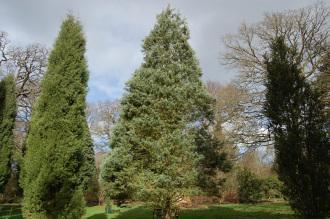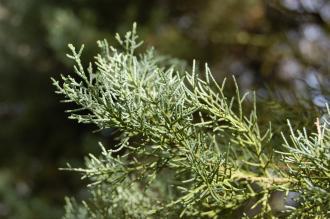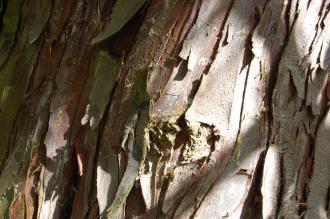
Cupressus bakeri (01/03/2015, Kew Gardens, London)
Position: Full sun
Flowering period: Spring
Soil: Moist, well drained
Eventual Height: 30m
Eventual Spread: 10m
Hardiness: 6a, 6b, 7a, 7b, 8a, 8b, 9a, 9b, 10a
Family: Cupressaceae
Cupressus bakeri is a slow growing, long lived, evergreen conifer with a conical habit. Its dull grey/ green leaves are scale like, fragrant when crushed, up to 5mm long and produced on rounded shoots. Its trunk may achieve a diameter of up to 50cm. Its grey/ red/ brown bark is fibrous, thick and peels off in longitudinal strips. Its monoecious flowers appear as cones, the male being globular and up to 5mm long and the female globose to oblong, up to 25mm long, are green/ brown when young and maturing to gray to grey/ brown.

Cupressus bakeri Leaf (01/03/2015, Kew Gardens, London)
Cupressus bakeri, commonly known as Baker Cypress, Modoc Cypress, or Siskiyou Cypress, is native to south west Oregon and north California, USA. In its native habitat it grows in small scattered populations in mixed evergreen forests at an altitude of between 900 and 2000m. This tree is classified as Vulnerable according to The IUCN Red List of Threatened Species.
The etymological root of the binomial name Cupressus is derived from the old Latin name for ‘Italian cypress’. Bakeri is named after Charles Henry Baker (1848-?), a botanist from USA.
When available landscape architect may find Cupressus bakeri useful as a slow growing evergreen tree suitable for climates with low humidity and mineral soils. Once established this tree is drought tollerant.

Cupressus bakeri Bark (01/03/2015, Kew Gardens, London)
Ecologically, Cupressus bakeri may provide cover for birds.
Cupressus bakeri prefers moist, well-drained mineral soils. It tolerates most pH of soil, although it prefers a slightly acid soil.
Cupressus bakeri requires little maintenance.

